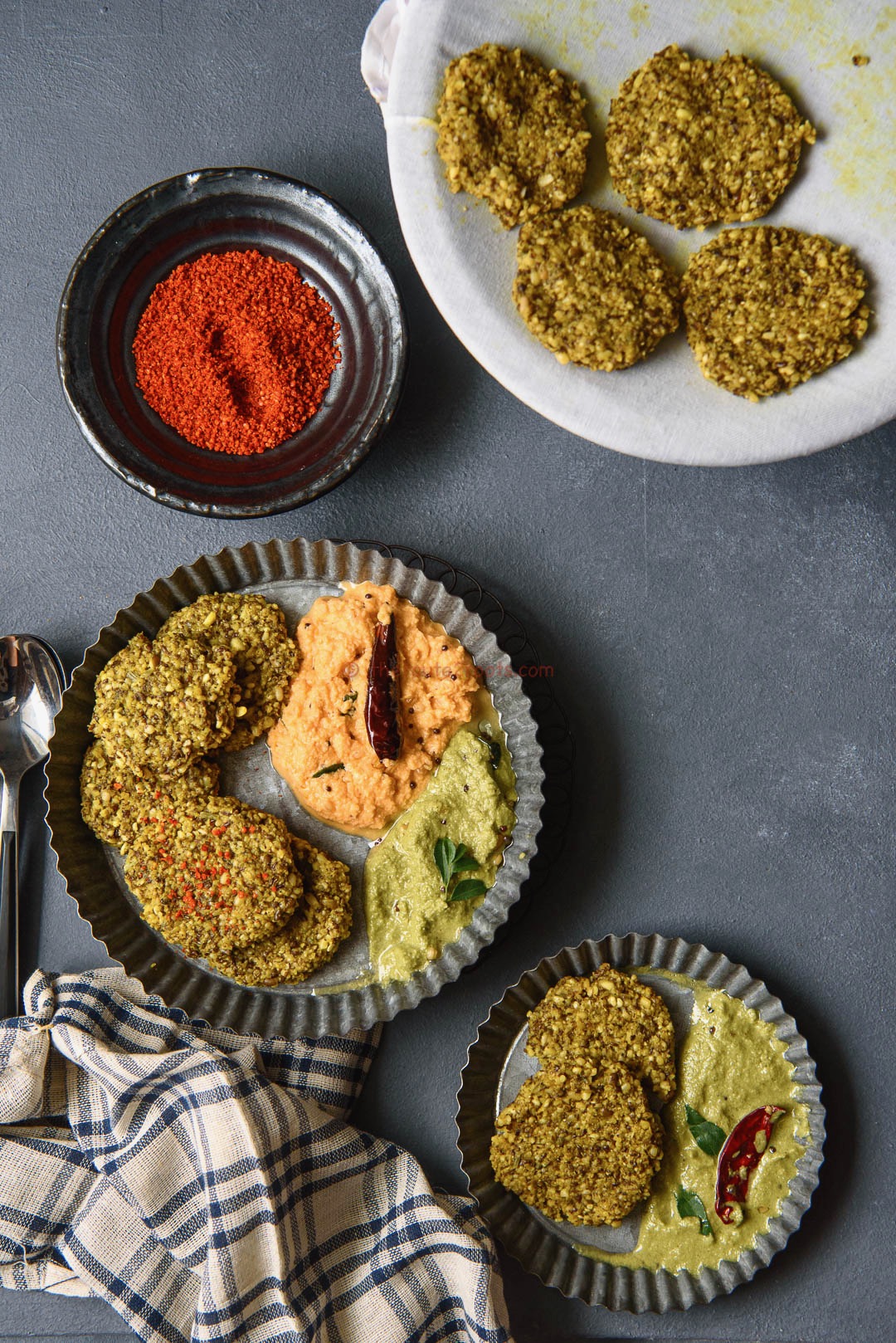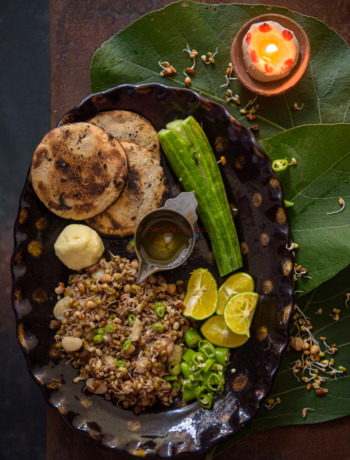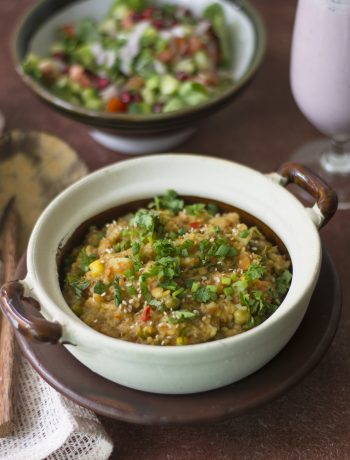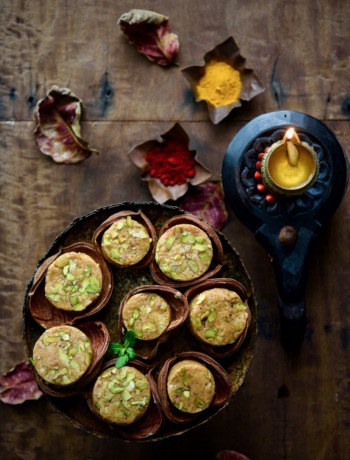“Oh yes, I remember these. We call them Tipela Dhokla/patted dhokla,” Pinky was quick to respond. One of the best outcomes of theroutetoroots journey has been the friendships it has helped me built. Food connects and how!! Pinky and I connected over Damni Dhokla post, she went on to help me document the elusive Kundi-Dhoko, a kitchen implement that has lost is relevance (more because we are not aware of the difference it imparts to the final batter) but families like her’s have chosen to hold on to it tightly. Recently, I reached out to her with an image from a Tarla Dalal book on Gujarati Cuisine. The image of Pandoli steaming over a cheesecloth tied to a tapeli/patili/saucepan had always intrigued me whenever I chanced upon it. I had never heard or seen anything made like so, but the ingredient list appeared very Jain in nature.
“Sadly, we do not make them any more but the Tipela Dhokla was a once-in-a-year occurrence, cooked by my Dadi whenever she and my mother hand-milled mung-bean to mung dal for our joint-family of 15 members…Each year in December-January, 40 kilos (yes, Jains eat a lot of mung beans, their breakfast would be tempered mung – beans and Khakhra) the desi/heirloom mung-beans would arrive at our Ahmedabad home from our native village. Since the beans were an heirloom variety there was the difference in sizes, and they would not cook evenly if used without segregating. They were first washed and sundried to clean off undesired particles. Later, using ‘aadaver ni Charni’ (a special kind of sieve used to segregate grains of these kind) they were separated by size. The bigger grains were kept whole, the smaller would turn into dal and the tukda used for dhokla and the residue would be sent to be milled into flour and used to make mug na wada and khichu. On a day when work would be easy at the home front, my grandmother and mother would set out on the task to hand-mill around 20 kilograms of moong-beans into moong dal. It was 4-5 hours of intense work when both of them took turns in pouring and milling the mung in a manual grain mill. Once the beans were milled, the resultant dal (lentil) was separated from tukda/daliya (small broken bits). As Jains, when it is about food, we practice the zero-waste philosophy. In the evening, my dadi would make the Tipela Dhokla with the tukda/daliya textured mung beans. It was a recipe engineered to make use of the in-between textured moong beans that neither qualified as dal nor gruel… It was a quick recipe since there was no need to ferment the batter nor a long list of ingredients to be gathered. A dropping consistency batter was made using the tukda, green chilies, ginger, salt, hing, handi were added along with some besan to bind. The batter was patted over the fingers and slipped over the piece of old cotton saree or dhoti/cheesecloth tied over tapeli with water boiling within. Cloth was used to absorb moisture and prevent them from sticking with each other as they steamed in two layers separated by cloth. The dhokla steamed for 15-20 minutes and was eaten hot with ghee and buru sugar. Not to be confused with the other indulgent dhokla in Gujarati repertoire, the Tipela Dhokla is certainly an acquired taste. As kids, we never relished them but now as I understand and appreciate the philosophy behind such ingenious recipes, there is a fondness and respect for the traditional food practices of the yore!” Pinky shared over our chat on the phone.
Food on the plate was never taken lightly in the past, it was a privilege to afford or have access to foods we consider basics/staples today. Recipes were not designed around wheat, rice, sugar or oil as ‘they were a luxury,” my father often tells me. There was a barter system in practice hence, you primarily ate what was growing in the region. Most of us might find it difficult to comprehend these facts. We have come a long way when it comes to food security perhaps, the reason we now take our meals for granted!
After 20 years in IT, Pinky Jhaveri is living her dream of studying culinary arts. “I still love cooking very traditional foods using the same techniques my mum used!” she shares from San Francisco, a place she now calls home ❤️

Tipela Dhokla
Ingredients
- 1 cup mung dal/chilke wali moong dal/mung lentils
- 2 teaspoons ginger, minced
- 2 teaspoons green chilies, minced
- 1/2 teaspoon hing
- 1/2 teaspoon turmeric powder
- 1 tablespoon besan/chickpea flour (to bind)
- 1/4 cup coriander, chopped
- salt to taste
- 1 teaspoon oil (optional)
Instructions
In a coffee grinder or chutney jar of Indian style mixer grinder, pulse the mung dal a couple of times.
Do not over grind, we need to grind the dal to small bits
Now wash and soak the dal for at least 4 hours, I soaked overnight.
After the dal has soaked, prepare the batter or the mix for Tipela Dhokla.
In an adequately sized mixing bowl, take the soaked dal and mix in all the ingredients. Add oil if you wish to.
Let the batter rest while you prepare the steamer.
Wet the cheese cloth.
Tie the cheese cloth over the saucepan that has a lid to fit.
Fill the sauce pan with at least 3-4 glasses of water.
Take care that the water does not touch the cloth. Hence take a large saucepan.
Allow the water to come to a boil.
Once the water comes to a boil, pat the mix over wet fingers like shown in the trailing video, shape it like a small patty and spread the dhokla over the cloth.
Bring the overhang cloth (if you have it) over the dhokla and spread the second layer of Dhokla over it around the first layer (if you want to) or steam them for approximately 15 minutes, the way you see in the video.
To check the doneness of the dhokla, insert a knife, if it comes out clean the Dhokla are done.
Serve hot with ghee and bura sugar or chutneys of your choice.
Notes
You will also need a cheese cloth or a soft piece of cotton cloth from old sari or dhoti. A large colander/saucepan/patili with large mouth. These Dhokla become hard once they cool, hence should be eaten warm.





2 Comments
Brad
October 15, 2020 at 8:57 amI recently discovered your website and want to thank you for your wonderful work! My girlfriend is from Surat and we have a limited collection of recipes from her family. I have always loved their cooking, and now you have given us a way to incorporate other traditional Gudjrati food into our home. Thank you!
Sheetal
October 20, 2020 at 7:01 amThank you Brad for stopping by and leaving such encouraging comment. I hope you enjoy this space as much I enjoy creating it. Do let me know how the recipes turn out…
Regards!!